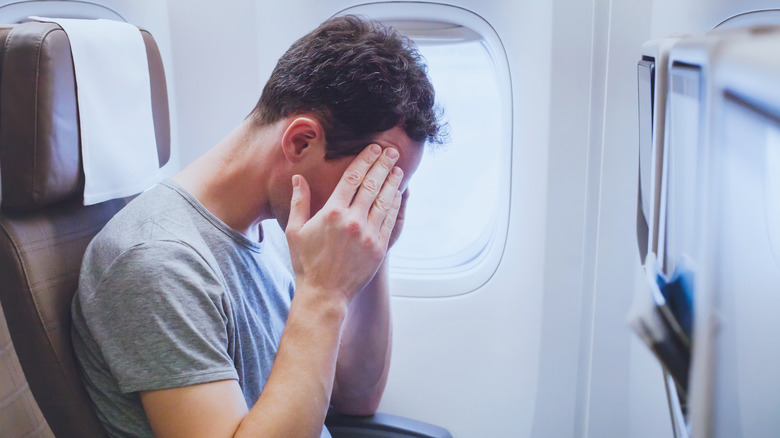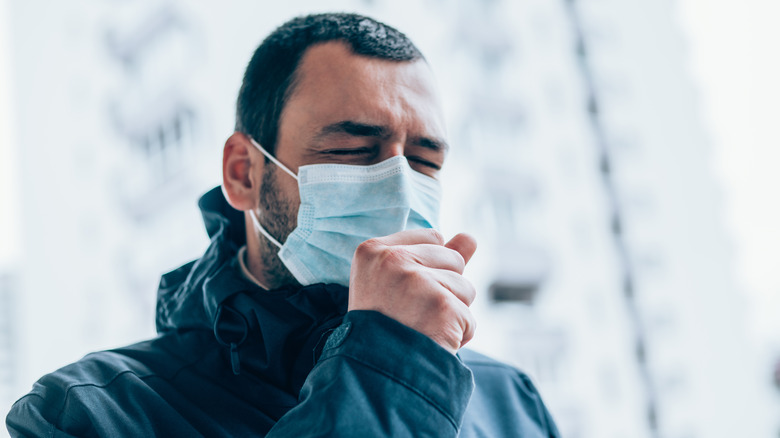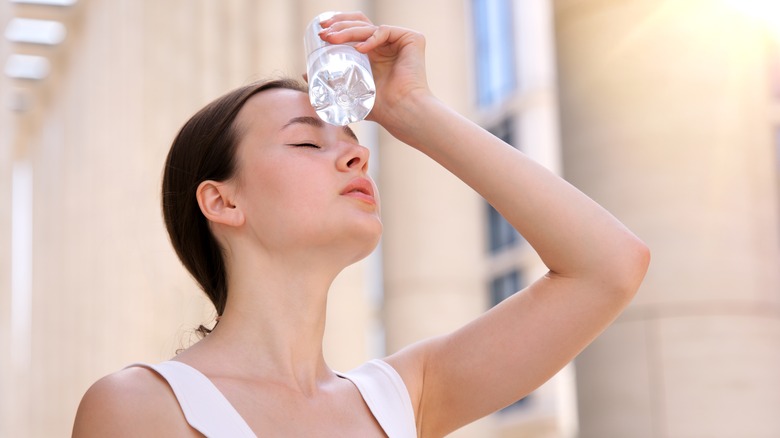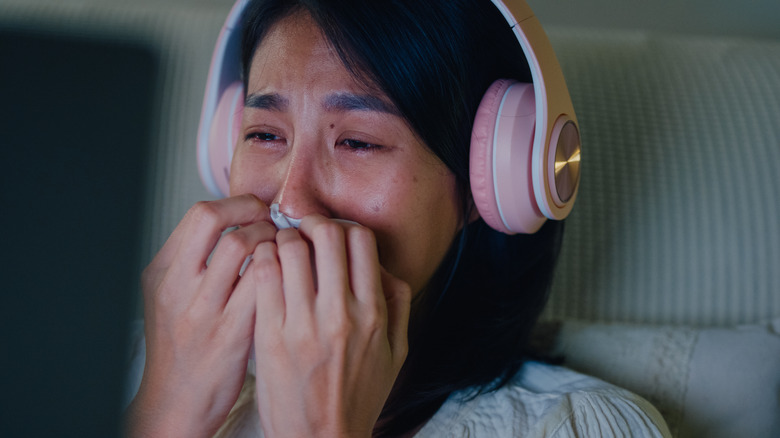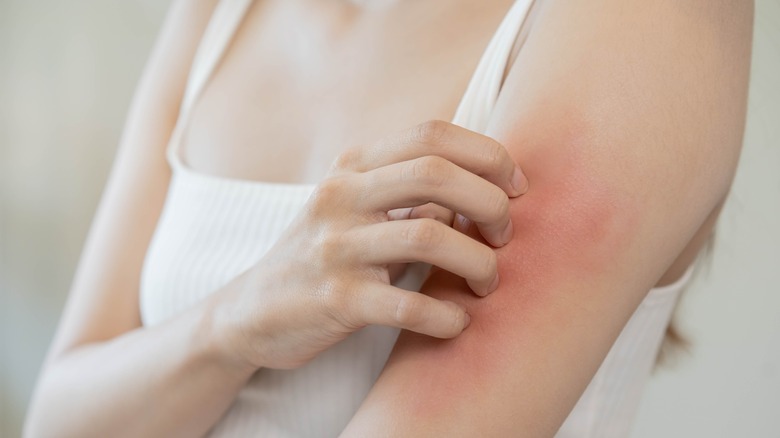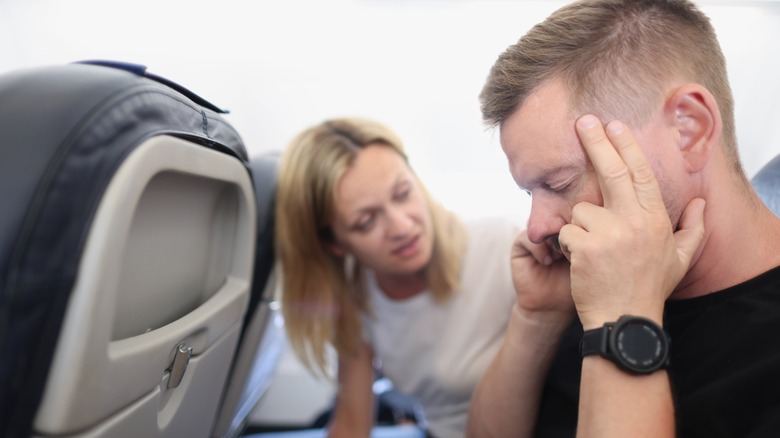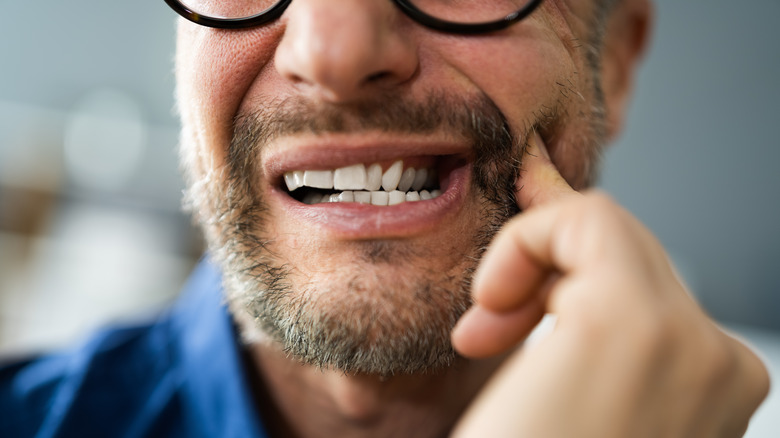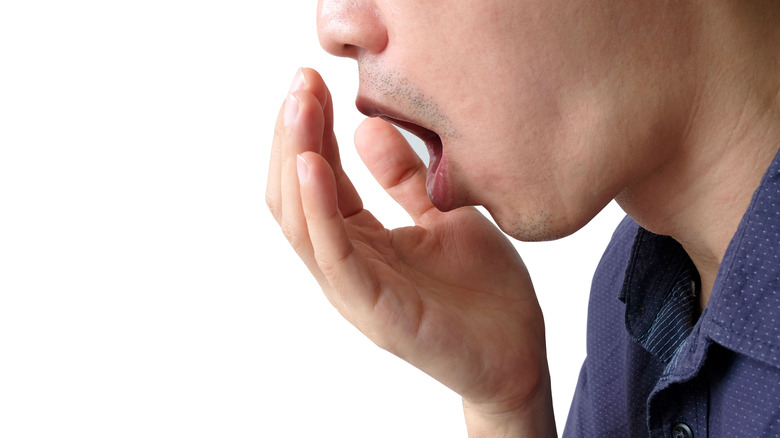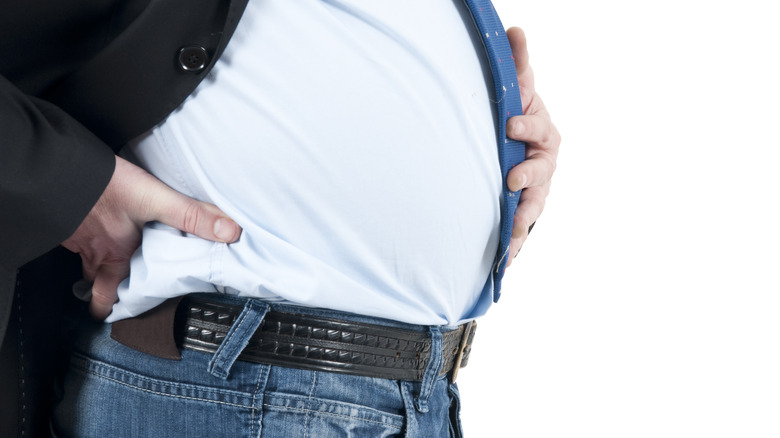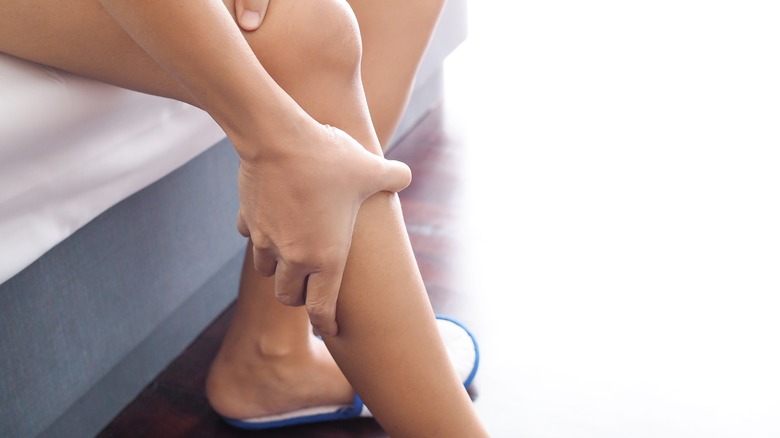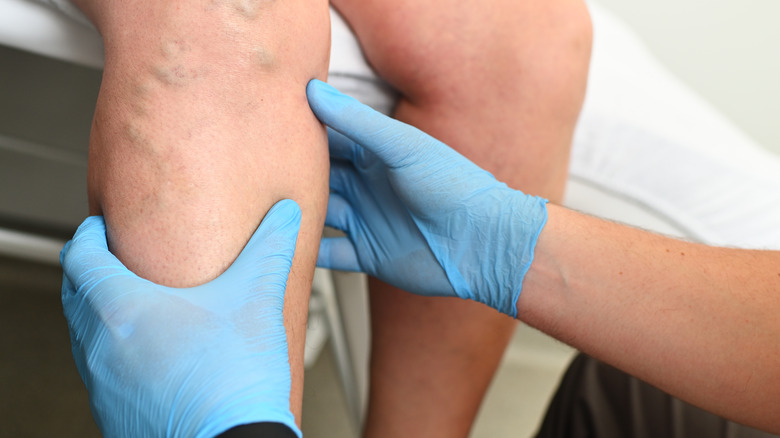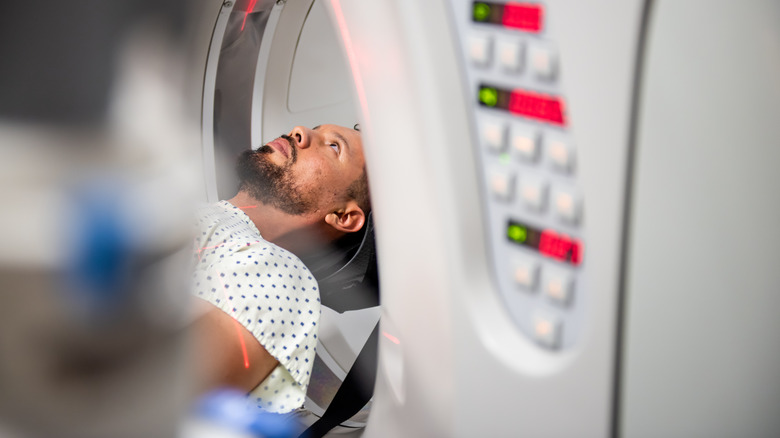The Most Bizarre Effects Travel Has On The Human Body
Many people love traveling, but unless they're flying in a private jet, chances are they enjoy the part of the journey that comes after landing. Air travel is often chaotic and stressful, usually starting with quibbling about the best way to get to the airport. Then it piles on: inevitably standing at baggage claim, dealing with the stress of losing your checked bags, and wondering which one of the many identical suitcases belongs to you. As it turns out, the stress isn't in your head.
Modern air travel is a burdensome, uncomfortable experience that manifests in the body in multiple ways. Many of the issues stem from three root causes: dry air, changing air pressure, and cramped quarters. This unholy trinity weakens the immune system, leaving the body ill-prepared to fight everything from a cold to a pulmonary embolism. We've compiled some of air travel's most bizarre effects on the human body, along with suggestions for how to avoid or at least improve them. Hint: Getting an aisle seat and a little bit of water can go a long way — however, think twice before bringing this popular reusable water bottle on a plane.
Your immune system is weakened
Studies have shown that air travelers are 100 times more likely to get sick flying on planes, and it's primarily due to a severely weakened immune system. It's a bit of a vicious chicken-or-the-egg cycle: The hazardous side effects of air travel compromise the immune system and further worsen because the body's defenses are jeopardized. Additionally, this weakened immune system has to fight many more pathogens than it is used to, leaving the body exhausted and overburdened.
The immune system is enfeebled by a number of aggravating factors stemming from prolonged exposure to a cramped, artificial environment. First, air cabins are actually significantly drier than the Sahara Desert, which can easily lead to dry skin and dehydration. Dehydration can cause digestive issues, reduce cell function and blood flow, and promote inflammation, which all incapacitate the immune system. Furthermore, fluctuating pressure, oxygen, and temperature cause the expansion of the stomach, where 80% of immune cells are located.
At 35,000 feet, oxygen levels are far lower, further inhibiting proper cell production. A compromised stomach means an impaired immune system. Additionally, the cramped, uncomfortable seating leads to poor blood circulation, making it harder for the immune cells to reach the areas where they're needed. To give your immune system a fighting shot, drink lots of water to avoid dehydration, carry hand sanitizer and sanitizing wipes, avoid coffee or alcohol, and get up and stretch periodically.
You may get dehydrated
As previously mentioned, cabin air is even drier than the Sahara Desert. Most of the air circulating in the cabin comes from outdoors, and at 35,000 feet, the air has almost no moisture. Ideal humidity is between 30% and 60%, and at cruising altitude, the humidity is just 10% to 20% — for perspective, the Sahara's is 25%. Spending hours in this desert-dry air may lead to mild to severe dehydration, which is partially responsible for most of the side effects of air travel, as well as headaches, dizziness, fatigue, and nausea.
Luckily, there are a few strategies to avoid this root cause of so many travel travails. The first, unsurprisingly, is to drink a lot of water. Experts recommend packing an airplane-approved reusable water bottle and filling it up after you get through security with our step-by-step guide. Honestly, bring as much water as you have room for. Experts also recommend packing Pedialyte Powder Packs, which contain electrolytes and can increase hydration more than regular water. Bring along fruits and vegetables, too, as they aid hydration much more than the sugary or salty snacks airlines provide.
Finally, learn to recognize the signs of dehydration, which can sneak up on you before you're thirsty. Symptoms include dry eyes, mouth, and skin, headaches, fatigue, dizziness, and vibrantly hued urine. Bottom line: Carry lots of water and the moment you feel out of sorts, have another sip.
You get more emotional
If a cheesy rom-com offered by in-flight entertainment has ever made you a member of the "Mile Cry Club," don't be embarrassed — you're in good company. According to CNN, a 2011 study by Virgin Atlantic found that 55% of respondents said they experienced heightened emotions on a flight, and 41% of male respondents even admitted to hiding under their blankets to hide their tears. Just a cursory analysis of the entire travel process, from the days leading up to the flight to its jetlagged aftermath, shows there are ample reasons why so many travelers can get a bit weepy.
First, the whole process is stressful, from packing and planning to going through security to trying to find the right gate, all while the clock ticks and you're positive you're missing at least one important item. But for many, the real stress begins after the airport obstacle course, when travelers squeeze into tiny seats surrounded by agitated strangers. For some passengers, air travel means saying goodbye to loved ones or facing a major life change. Others may feel trapped or fear for their safety.
There are physiological reasons as well: lower-than-usual air pressure can lead to mild hypoxia, which occurs when the body doesn't get enough oxygen. Hypoxia and possible dehydration from the drier-than-the-Sahara air cabin can lead to extreme moodiness. For some, these factors result in crying. For others, they lead to the kind of rage that turns them into overnight internet villains.
Your skin and eyes become dry
If you're ever embarrassed about crying, no need to hide under those scratchy blankets — instead, you can blame your red, puffy face on the low humidity. Another casualty of the dry air is the skin, which is used to 40% to 50% humidity, while plane cabins have 10% to 20% humidity. As a result, the skin loses a lot of its moisture, which can lead to the infamous "flight face," as well as itchy, dry skin. Anyone with eczema, psoriasis, or other skin conditions may experience breakouts.
To make matters worse, the lack of moisture also causes the skin to produce more oils, which can sometimes lead to acne breakouts. And those tears you were just crying will evaporate more quickly than usual, which can lead to dry, itchy eyes. The dryness and possible dehydration can result in irritation all over the body, including the nose and mouth. The body's constricted blood flow may also leave the skin looking duller.
For the image and (or) itchiness-conscious, this is just one more thing to cry about. Luckily, there are a few steps you can take to avoid or mitigate symptoms. In the week leading up to and during the flight, drink as much water as you can. The night before, moisturize your whole body, and bring a travel-size container with you, alongside eye drops and nasal spray. Steer clear of hot showers before the flight, don't wear makeup, and avoid coffee and alcohol.
You get airplane ear
Chances are that if you go up to someone on the street and ask about the side effects they most associate with planes, they'll mention struggling to prevent popping ears during a flight. Airplane ear, formally known as ear barotrauma, occurs when there's an imbalance in the middle ear and air pressure. When planes take off or land, the air pressure changes quickly, and the eustachian tube, the canal responsible for equalizing air pressure in the middle ear with the outside, doesn't have enough time to respond. The result is popped ears, discomfort, stuffiness, and some hearing loss.
In more severe cases, airplane ear can result in intense pain, vertigo, ringing or even bleeding from the ear, and moderate to severe hearing loss. Anyone who's ever been unlucky enough to have to fly with a cold or sinus infection will tell you that it can be extremely painful. Luckily, the worst of it typically goes away after a few minutes, but if it lasts longer than a few days, see a doctor.
To keep your ears from popping on your next flight, yawn and swallow frequently during landing and takeoff, which activates muscles that open the eustachian tubes. Sucking candy or chewing gum can also help. Some people also find gently blowing while pinching the nose and keeping the mouth closed to be effective. Others say it can make it even worse and recommend taking nasal spray or oral decongestants about 30 minutes before takeoff or landing.
Your sense of smell and taste are dulled
Flying can affect the eyes, ears, skin, and brain — now let's move to the nose and the mouth. The same old culprits, low humidity and air pressure, lead to reduced blood oxygen levels, affecting odor receptors, which in turn messes up taste buds. Strangely, loud noise from the outside engines can also reduce taste bud sensitivity, particularly to sweet and salty foods. In fact, passengers' sensitivity to sweet and salty food is reduced by up to 30%, according to a 2010 study by Fraunhofer IBP, commissioned by Lufthansa.
An executive at AeroMexico claimed to CNN that passengers lose up to 70% of their sense of taste while on planes. This probably explains why Anthony Bourdain avoided eating airplane food. However, credit is due. The chefs behind airline food work much harder than you'd expect to mass-produce meals; some acknowledge the loss of taste by purposefully adding extra salt to meals to compensate. Singapore Airlines devoted an entire section of Changi Airport to simulate the conditions of an airplane at 35,000 feet in order to develop tasty food. No wonder it was rated the world's best airline in varied categories by multiple publications.
While passengers don't taste salty and sugary foods as much, the Lufthansa-commissioned study found that their perception of fruity and acidic foods remained constant. Some seasonings like cardamom and curry paste tasted stronger than they did on the ground. Therefore, meal enjoyment is not entirely futile on a plane.
You may get a toothache
Even a five-star meal loaded with Himalayan sea salt, meticulously tested in a simulated air cabin, will still be a miserable experience to anyone afflicted with another common airplane side effect: toothache. The good news is that if you take good care of your teeth, this one probably won't affect you. But if you walk into the flight with a cavity, infection, or even a crack in one of your teeth, the low pressure can cause the air pockets to expand, resulting in a nasty ache.
If you get a toothache on a flight, it's a sign that you need to see a dentist not long after you land. It could also mean you have sinus congestion or a sinus infection. The low air pressure also causes the sinuses to increase, and the pressure can transfer to the teeth. Whatever the unpleasant cause, the pain can be managed on the flight with some over-the-counter painkillers like Ibuprofen or analgesics like Orajel.
On that note, painkillers for flights and water to wash them down is an excellent idea for many different reasons. Stay hydrated, but avoid anything too hot or too cold. Steer clear of hard foods as well, though chewing gum can help.
You get bad breath
Dehydration and sudden changes in air pressure can wreak another form of havoc inside your mouth, but this is one the person sitting inches away from you might be all too aware of. The change in air pressure can mess up the body's functions, including the production of saliva, which contains antibacterial properties that help keep the mouth clean. Additionally, a dry cabin dries out the mouth, creating the ideal environment for odor-causing bacteria. The result? The infamous "traveler's breath"; one of the symptoms that makes everyone near you just as unhappy as you are.
Luckily, this one is easy enough to address, and the solutions are fairly predictable. To start, indulge yourself in the answer to so many of the problems we have discussed: water, water, and more water. This will help replace the work that saliva would normally do. Secondly, in the confusing chaos of air travel, many passengers forgo their usual brushing and flossing routines. But while it's certainly not ideal to brush and floss in an airplane or airport bathroom, it is possible. Bring along a small, portable toothbrush, floss, mouthwash, and even a tongue scraper, and your seatmates will be eternally grateful. Just in case, pack some breath and tongue spray and sugar-free chewing gum, and eat as much healthy food as you can.
You may become gassy
Even if you brush and floss your teeth and gums to perfection, you may be afflicted with another odorous problem that's not quite as easy to get rid of. When airplanes ascend, and cabin pressure drops, the amount of gas expands in the stomach and intestines, sometimes as much as 30%. The high altitude also slows down the muscle contractions that keep the contents of the digestive system moving, leading to a large buildup of gas. For you and all the people in close proximity, this can quickly become a humiliating nightmare.
The first thing we'd recommend is an aisle seat. Social conventions may compel you to hold in your gas, but this is harmful and will cause a larger buildup that will need to get out at some point. It will also help your intestines and blood flow to get up and move around from time to time. Second, avoid foods and seasonings known to cause gas, like beans, carbs, dairy, or those that have a lot of salt, onion, and garlic.
Opt instead for at least one meal containing seasonal vegetables, and eat slowly. Avoid caffeine or alcohol in favor of herbal tea, and, as always, drink lots of water. But just in case, bring medications like Gas-X or Beano, and consider items like charcoal underwear, charcoal pads, or gas relief pads.
Your feet and legs may swell
It's not just your intestines swelling — your feet and legs might get a little bit bloated as well. Sitting for an extended period of time restricts the proper flow of blood from the legs and feet, causing it to pool inside the veins. The changes in air pressure also pull the fluids of the body downwards, causing them to accumulate in the lower regions. You may picture giant, visible swelling, but the condition known as "dependent edema" can manifest in other ways, including unusual tightness in the legs, ankles, and shoes; difficulty moving or flexing the feet and ankles; or aching or throbbing in the feet.
This is typically harmless, but if symptoms don't end a few days after the flight, you may be experiencing clotting and should see a doctor immediately. More about that in the next slide. To avoid swelling, opt for seats with extra legroom, and get up and move around as often as you can. Be sure to wear loose, comfortable clothing and shoes; consider compression stockings and snug-fitting, stretchy socks that gently squeeze the legs to promote circulation. Avoid crossing your legs, which impedes blood flow, and steer clear of sodium foods, which also contribute to swelling.
You may get blood clots
In more serious cases, the same conditions that lead to swelling can also result in blood clots, also known as Deep Vein Thrombosis (DVT). DVT births pain, swelling, red skin, and unusual warmth of the affected leg. It can also cause difficulty in breathing, chest pain, racing heartbeat, and coughing up blood. In the worst-case scenario, DVT breaks off and travels to the blood vessels of the lungs, leading to a pulmonary embolism that can result in sudden death. These cases are rare but worth preparing for.
First, be aware of the risk factors, which include a personal or family history of clotting, a current or recent pregnancy, use of oral contraceptives or birth control that includes estrogen. Others are recent surgery, old age, obesity, cancer treatment, and any other serious medical conditions like a stroke or heart disease. If you fall into any of these categories, consult a hematologist a few months ahead of the flight so you can begin the proper treatment.
For anyone else, the tips for prevention or mitigation are similar to those of foot and leg swelling. Drink water and avoid sodium, coffee, and alcohol; wear loose clothing and compression stockings, and move around when you can. You can even exercise while sitting down by raising and lowering your legs repeatedly.
You may have an increased risk of cancer
Before you panic, it's important to note that several studies have found elevated risks for various types of cancer for pilots and flight attendants. But that means that anyone who flies frequently is exposed to similar risks. A 2018 study by the Harvard School of Public Health found that flight attendants have a higher prevalence of several forms of cancer, including breast, uterine, gastrointestinal, and cervical. The Air & Space Forces Association also found that pilots were 24% more likely to be diagnosed with various forms of cancer than nonpilots. According to the study, these increased risks stem from continuous exposure to ultraviolet rays, which come in stronger in the skies due to the thinner atmosphere. Another research found that flying for under an hour in the pilot's seat at 30,000 feet had the same carcinogenic radiation effect as spending 20 minutes in a tanning bed.
While "cosmic ionizing radiation" is the most frequently cited reason, crew and frequent fliers are also exposed to a number of factors that could contribute to cancer, including circadian rhythm disruption and possible chemical contaminants in the cabin. Some have argued that radiation from TSA scanning machines could contribute to cancer, though most reliable sources say that not all scanners use them, and the ones that do employ negligible amounts. But don't panic: One 2017 study published in The Conversation found that even flying 370,000 miles increases cancer risk by just 0.01% (via Scientific American).
